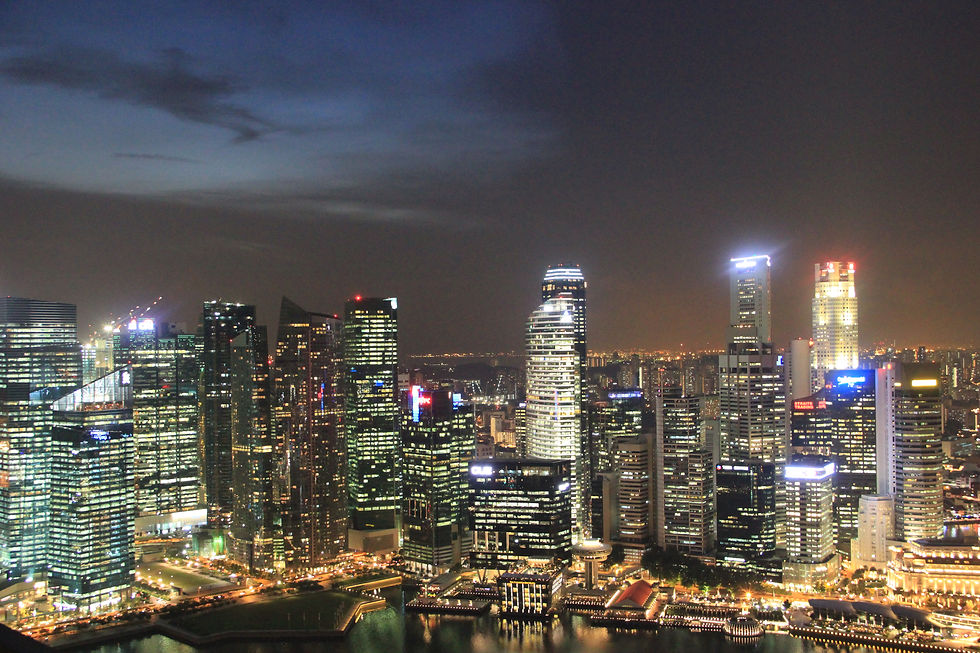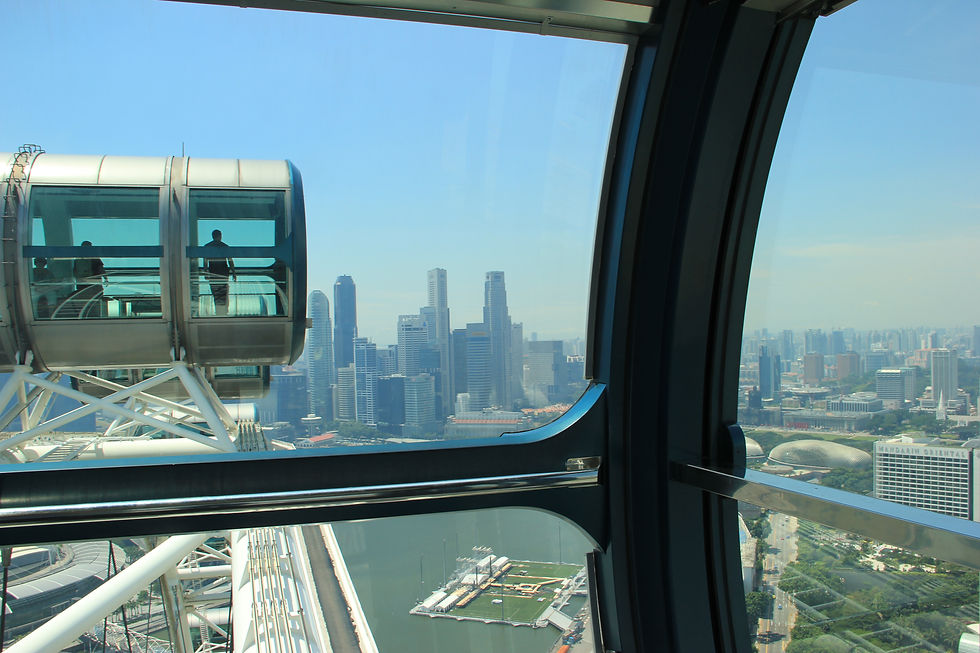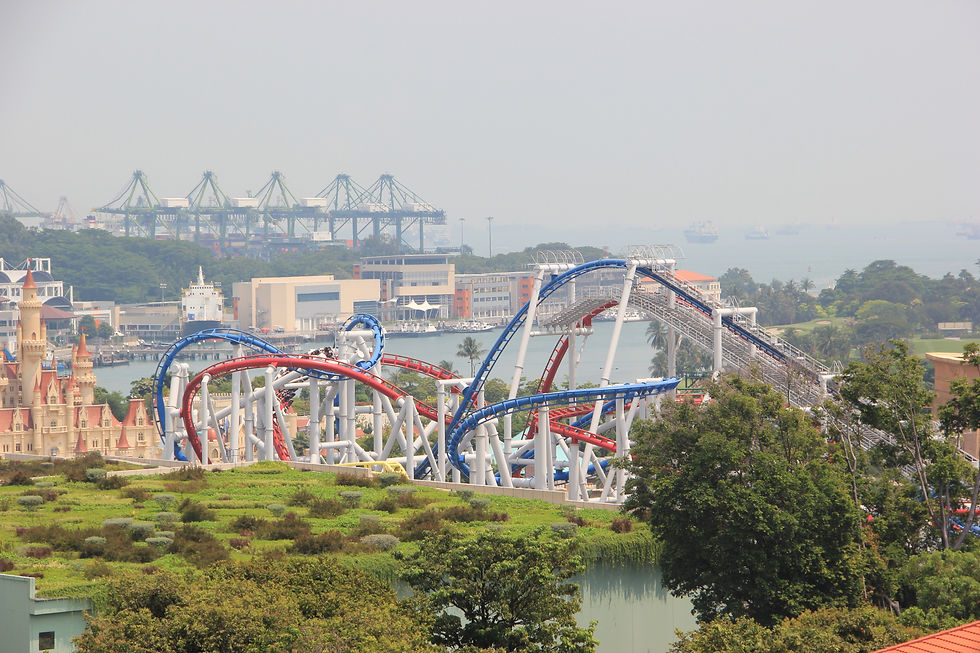Singapore
- mpluhar9
- Nov 19, 2012
- 14 min read
Singapore officially the Republic of Singapore, is a sovereign city-state and island country in Southeast Asia. It lies off the southern tip of the Malay Peninsula and is 137 kilometres (85 mi) north of the equator. The country's territory consists of the lozenge-shaped main island, commonly referred to as Singapore Island in English and Pulau Ujong in Malay, and more than 60 significantly smallerislets. Singapore is separated from Peninsular Malaysia by the Straits of Johor to the north, and from Indonesia's Riau Islands by the Singapore Strait to the south. The country is highly urbanised, and little of the original vegetation remains. The country's territory has consistently expanded through land reclamation.

The islands were settled in the second century AD and subsequently belonged to a series of local empires. Modern Singapore was founded in 1819 by Sir Stamford Raffles as a trading post of the East India Companywith permission from the Johor Sultanate. The British obtained sovereignty over the island in 1824, and Singapore became one of the British Straits Settlements in 1826. Occupied by the Japanese during World War II, Singapore declared independence from the United Kingdom in 1963 and united with other former British territories to form Malaysia, from which it was expelled two years later through a unanimous act of parliament. Since then, Singapore has developed rapidly, earning recognition as one of the Four Asian Tigers.
Singapore is one of the world's major commercial hubs, with the fourth-biggest financial centre and one of the five busiest ports. Its globalised and diversified economy depends heavily on trade, especially manufacturing, which represented 26 percent of Singapore's GDP in 2005. In terms of purchasing power parity, Singapore has the third-highest per capita income in the world but one of the world's highest income inequalities. It places highly in international rankings with regard to education, healthcare, and economic competitiveness. Approximately 5.4 million people live in Singapore (June 2013), of which approximately two million are foreign-born. While Singapore is diverse, ethnic Asians predominate: 75 percent of the population is Chinese, with significant minorities of Malays, Indians, and Eurasians. There are four official languages, English, Malay, Mandarin, and Tamil, and the country promotes multiculturalism through a range of official policies.
Singapore is a unitary multiparty parliamentary republic, with a Westminster system of unicameral parliamentary government. The People's Action Party has won every election since self-government began in 1959. The dominance of the PAP, coupled with a low level of press freedom and suppressed civil liberties and political rights, has led to Singapore being classified as a semi-authoritarian regime. One of the five founding members of the Association of South East Asian Nations (ASEAN), Singapore is also the host of the Asia-Pacific Economic Cooperation (APEC) Secretariat, and a member of the East Asia Summit, the Non-Aligned Movement, and the Commonwealth. Singapore's rapid development has given it significant influence in global affairs, leading some analysts to identify it as a middle power.
Port of Singapore
The Port of Singapore refers to the collective facilities and terminals that conduct maritime trade handling functions in harbours and which handle Singapore's shipping. Currently the world's second-busiest port in terms of total shipping tonnage, it also trans-ships a fifth of the world's shipping containers, half of the world's annual supply of crude oil, and is the world's busiest transshipment port. It was also the busiest port in terms of total cargo tonnage handled until 2005, when it was surpassed by the Port of Shanghai. Thousands of ships drop anchor in the harbour, connecting the port to over 600 other ports in 123 countries and spread over six continents.
The Port of Singapore is not a mere economic boon, but an economic necessity because Singapore is lacking in land and natural resources. The Port is critical for importing natural resources, and then later re-exporting products after they have been refined and shaped in some manner, for example wafer fabrication or oil refining to generate revenue. The service industries such as hospitality services typical of a port of call restock the food and water supplies on ships. Ships pass between the Indian Ocean and the Pacific Ocean through the Singapore Straight. The Straits of Johor on the country's north are impassable for ships due to the Johor-Singapore Causeway, built in 1923, which links the city of Woodlands, Singapore to Johor Bahru in Malaysia.


The port is the world's busiest port in terms of shipping tonnage handled, with 1.15 billion gross tons (GT) handled in 2005. In terms of cargo tonnage, Singapore is behind Shanghai with 423 million freight tons handled. The port retains its position as the world's busiest hub for transshipment traffic in 2005, and is also the world's biggest bunkering hub, with 25 million tonnes sold in the same year.
Singapore is ranked first globally in 2005 in terms of containerised traffic, with 23.2 million Twenty-foot equivalent units (TEUs) handled. High growth in containerised traffic has seen the port overtaking Hong Kong since the first quarter of 2005, and has led the race ever since, with an estimated 19,335 TEUs handled in the year up to October, compared to 18,640 TEUs handled in Hong Kong in the same period. A rise in regional traffic consolidating the port's position in Southeast Asia, and increases in transshipment traffic using the strategic East Asia-Europe route via Singapore helped the port to emerge tops at the end of the year, a title it had not held since overtaking Hong Kong once in 1998.
Singapore port played vital role in emerging economy.
Merlion
The Merlion is a traditional creature in western heraldry that depicts a monster with a lion head and a body of a fish. In Singapore, it has become a marketing icon used as a mascot and national personification of Singapore. The merlion—a statue with the body of a fish and the head of a lion—occurs in a number of different artistic traditions. Lions with fishtails can be found on Indian murals at Ajanta and Mathura, and on Etruscan coins of the Hellenistic period. Merlions, or ‘heraldic sea-lions’, are an established element of Western heraldry, and have been used on the coat of arms of the cities of Portsmouth and Great Yarmouth in the United Kingdom; the City of Manila; and the East India Company. The Merlion is the national personification of Singapore.

Its name combines "mer" meaning the sea and "lion". The fish body represents Singapore's origin as a fishing village when it was called Temasek, which means "sea town" in Javanese. The lion head represents Singapore's original name—Singapura—meaning "lion city" or "kota singa".
The symbol was designed by Alec Fraser-Brunner, a member of the Souvenir Committee and curator of the Van Kleef Aquarium, for the logo of the Singapore Tourism Board (STB) in use from 26 March 1964 to 1997 and has been its trademarked symbol since 20 July 1966. Although the STB changed their logo in 1997, the STB Act continues to protect the Merlion symbol. Approval must be received from STB before it can be used. The Merlion appears frequently on STB-approved souvenirs.
Marina Bay Sands
Marina Bay Sands is an integrated resort fronting Marina Bay in Singapore. Developed by Las Vegas Sands (LVS), it is the world's most expensive building, at US$ 4.7 billion, including the cost of the prime land.
Marina Bay Sands is situated on 15.5 hectares of land with the gross floor area of 581,000 square metres. The iconic design has transformed Singapore's skyline and tourism landscape since it opened on 27 April 2010. The property has a hotel, convention and exhibition facilities, theatres, entertainment venues, retailers and restaurants.

The Marina Bay Sands hotel has three 55-story towers with 2,561 luxury rooms and suites, which is capped by the Sands SkyPark, which offers 360-degree views of Singapore's skyline. The SkyPark is home to restaurants, gardens, a 150-metre vanishing edge pool, manufactured by Natare Corporation in Indianapolis, Indiana, and the world's largest public cantilever housing an observation deck. This architectural marvel stands at the height of 200 metres and boasts 12,400 square metres of space. Dining options at the Skypark include local celebrity chef restaurant, Sky on 57 restaurant and nightclub KU DÉ TA, and executive club lounge The Club at Marina Bay Sands.

To help the Skypark withstand the natural motion of the towers caused by wind, engineers designed and constructed four movement joints beneath the main pools, each possessing a unique range of motion. The total range of motion is 500 millimetres (19.68 inches). In addition to wind, the hotel towers are also subject to settlement in the earth over time, hence custom jack legs were built and installed to allow for future adjustment at more than 500 points beneath the pool system. This jacking system is important primarily to ensure the infinity edge of the pool continues to function properly.
Connected to the hotel towers are the Sands Expo and Convention Centre, Marina Bay Sands Casino and The Shoppes at Marina Bay Sands.

The Sands Expo and Convention Centre has more than 120,000 square metres or 1.3 million square feet of meeting space, making it one of the largest and most flexible locations in Asia. It is also the biggest MICE (Meeting, Incentives, Conference and Exhibitions) facility in Singapore, and the ballroom is the largest in Southeast Asia, capable of hosting up to 11,000 delegates. The Sands Expo and Convention Centre has five floors of exhibition and convention space, with up to 2,000 exhibition booths and 250 meeting rooms. It has hosted events ranging from banquets, theater-style conventions, to exhibitions and roadshows.
Located near the Sands Expo and Convention Centre is the Marina Bay Sands Casino. Spanning 15,000 square metres over four levels of gaming, the casino features over 600 gaming tables and 1,500 slot machines along with two noodle bars, The Nest and Tong Dim, and local Chinese eatery, Fatt Choi Express.
Another attraction found at Marina Bay Sands is The Shoppes at Marina Bay Sands. With close to 800,000 square feet of retail and restaurant space, The Shoppes at Marina Bay Sands is Singapore's first large-scale luxury shopping mall in the Central Business District with boutiques such as Ralph Lauren, Chanel, Cartier and Prada. Other luxury stores include Salon by Surrender, Gucci, Hermès, Emporio Armani, Chopard, REDValentino, Dior,Dunhill, Vertu, Miu Miu, Saint Laurent Paris, Salvatore Ferragamo, Montblanc, Blancpain, and an Hermès Watch Boutique. Also housed within the Shoppes are the five of the six Celebrity Chef Restaurants – Cut (by Wolfgang Puck), Waku Ghin (by Tetsuya Wakuda), Pizzeria and Osteria Mozza (by Mario Batali), Guy Savoy (by Guy Savoy), and DB Bistro Moderne (by Daniel Boulud).
Other attractions within The Shoppes at Marina Bay Sands include a canal which runs through the length of the Shoppes, in the same style as the Venetian in Las Vegas, two Crystal Pavilions, one housing renowned nightclubs – Avalon and Pangaea and the other the world's largest Louis Vuitton boutique. An indoor skating rink (synthetic ice) measuring 6,500 square feet (600 m2) as well as the MasterCard Theatres, compromising of the Sands Theatre and Grand Theatre which seat 1,680 people and 2,155 people respectively can also be found at The Shoppes at Marina Bay Sands.
The MasterCard Theatres has played host to many international acts and plays since its opening, with Broadway smash musicals like The Lion King, Wicked, Annie, The Phantom of the Opera, Starlight Express and My Fair Lady. Other acts such as Cirque Éloize and A. R. Rahman's Jai Ho, located in the latter during their world tours. Additionally, Marina Bay Sands has played host to Fide Fashion Weeks for 3 consecutive years since its inception in 2011.
Visitors to the Event Plaza at The Shoppes can enjoy the nightly Wonder Full show, a 13-minute light and water show featuring lasers, lights, water movements and graphics, set against the backdrop of Marina Bay Sands.
Marina Bay Sands is also home to the ArtScience Museum, With a form reminiscent of the lotus, the ArtScience Museum has been called "The Welcoming Hand of Singapore". It features an adjustable roof waterfall which uses rainwater collected when the roof is sealed in the day.
The resort also features an Art Path designed by Moshe Safdie, incorporating 11 installations by five artists including Zheng Chongbin, Antony Gormley, and Sol LeWitt. The 11 art installations were commissioned to integrate seamlessly with Moshe Safdie's iconic architecture. These art installations form the largest art commissions ever completed as part of an integrated architectural process.
Singapore Flyer
The Singapore Flyer is a giant Ferris wheel in Singapore. Described by its operators as an observation wheel, it opened in 2008, construction having taken about 2½ years. It carried its first paying passengers on 11 February, opened to the public on 1 March, and was officially opened on 15 April. It has 28 air-conditioned capsules, each able to accommodate 28 passengers, and incorporates a three-storey terminal building.
The Flyer has an overall height of 165 metres (541 ft) and was the world's tallest Ferris wheel until the 167.6 m (550 ft) High Roller, which is 2.6 m (9 ft) taller than the Flyer, opened on the Las Vegas Strip in Nevada, US, on 31 March 2014. The previous record holder, the Star of Nanchang, in Jiangxi, China, is 160 m (525 ft) tall, although its 153 m (502 ft) diameter wheel is larger than the Flyer's 150 m (492 ft) wheel.




Sentosa
Sentosa is a popular island resort in Singapore, visited by some twenty million people a year. Attractions include a 2 km (1.2 mi) long sheltered beach, Fort Siloso, two golf courses, 14 hotels, and theResorts World Sentosa, featuring the theme park Universal Studios Singapore.
The island was renamed "Sentosa" in 1972, which means peace and tranquillity in Malay (from Sanskrit, Santosha), from a suggestion by the public. The Sentosa Development Corporation was formed and incorporated on 1 September 1972 to oversee the development of the island. Since then, some S$420 million of private capital and another S$500 million of government funds have been invested to develop the island.
In 1974 the Singapore Cable Car system was built, linking Sentosa to Mount Faber. A series of attractions were subsequently opened for visitors including Fort Siloso, Surrender Chamber wax museum, Musical Fountain, and the Underwater World. The causeway bridge was opened in 1992 connecting Sentosa to the mainland.




The Sentosa Monorail system was opened in 1982 to transport visitors across seven stations located around the western side of the island. On 16 March 2005, the monorail service was discontinued to make way for the new Sentosa Express, which commenced operations on 15 January 2007. An environmental assessment conducted by the government of Singapore concluded that the construction of the resorts on Sentosa would to result in high likelihood of high scale biodiversity loss, habitat destruction, soil erosion and climate change, as well as several other destructive ecological impacts, therefore, in the area that was to be cleared for the construction of the resorts, over two hundred trees and plants were replanted elsewhere on the island to minimise negative environmental impact.
In 2009, construction of a new foot bridge began. The S$70 million Sentosa Boardwalk includes themed gardens, shops and eateries. There are covered walkways and travellators along the boardwalk for rainy days. The boardwalk, officially opened by Deputy Prime Minister Teo Chee Hean on 29 January 2011, will provide visitors an alternative mode of travel to reach the island. Sentosa Boardwalk, designed by Aedas, was named Best Leisure Architecture in Asia Pacific and 5* Best Leisure Architecture in Singapore, at this year's Asia Pacific Property Awards.
Sentosa offers a variety of attractions, museums and other facilities to provide a variety of experiences, recreation and entertainment to visitors.
Tiger Sky Tower
is a free-standing observation tower. At a height of 110 m (360 ft) above ground and 131 m (430 ft) above sea level, it offers visitors a panoramic view of Sentosa, Singapore, and the Southern Islands.It has a lifting speed of 1.2 metres per second and weighs 200 metric tonnes. On a clear day, the view extends to parts of Malaysia, Johor Bahru (30 km / 18 miles), Indonesia,Pulau Bintan (45 km / 28 miles) and Pulau Bantan (43 km / 27 miles). At ground level, visitors enter a large disc-shaped air-conditioned cabin fitted with glass windows all round. The cabin then revolves slowly as it ascends the column of the tower. The cabin has a capacity of 72 visitors.
The Sky Tower now sits at the very spot of what was formerly known as the Dragon Court. It has a dragon statue in the centerpiece with water spouting out from its mouth. In one of its claws, it holds a previous logo of Sentosa which was used in the early 1980s. Its tail ends at the dragon trail at the northern part of Imbiah Lookout. The statue was demolished a few months before the groundbreaking ceremony of the sky tower. It was opened on 7 February 2004, is situated in the Imbiah Lookout zone in the centre of Sentosa and can be reached by Cable Car, Sentosa Luge Chair Lift, by Sentosa Express or by bus.
Merlion Statue
A gigantic 37-metre tall replica of the Merlion which was completed in 1996, it houses two viewing galleries and a souvenir shop. The Merlion statue once played a part in the world-famous Magical Sentosa show, but it had to drop the part after the show was shut down in March 2007 to make way for the construction of Resorts World Sentosa. The Sentosa Monorail used to pass by this gigantic statue, but now it is replaced by the Sentosa Express which still passes by the statue. The Merlion Statue played several parts in several performances at the famous Sentosa Musical Fountain, which included the Spirits Of Sentosa show, and the Magical Sentosa show.

Fort Siloso
located in the west of the island, the guns of this preserved fort still stand. Fort Siloso was built by the British in 1880s to guard the narrow western entrance to Keppel Harbour. It was later modernised. The fort guarded the western approaches to Singapore during World War II. By 1939 it was armed with two 6-inch (150 mm) Mark2 guns and two rapid firing 12-pounder guns. Fort Siloso is now the only surviving coastal gun battery from the twelve such batteries that made up Fortress Singapore at the start of the war.
The ammunition bunkers, barracks, tunnels, and gun emplacements of the fort are now open to visitors, as a military-themed attraction. Also on display is a collection of artillery guns dating from the 17th century to World War II. Life-sized replicas of British soldiers and other people were on display to depict lives at the fort in the past. There is also an exhibition with a large collection of photographs, documents and film clips.
The fort served as the place of internment of the Singaporean political prisoner Chia Thye Poh in the period from 1989 to 1993.
This attraction was once served by the Fort Siloso Monorail Station of the discontinued Sentosa Monorail, after the monorail closed in 2005, the station was repurposed to add onto this attraction.
MegaZip Adventure Park
located at the top of Mount Imbiah, MegaZip Adventure Park is Singapore's first adventure park with one of the longest and steepest zip wires in Asia, a 3 levels, 40 feet high ropes ultimate physical challenge course a 50 foot drop free-fall (Para Jump) simulator, a challenging 16 metre high rock climbing wall(North Face) and Asia's most extreme zip line of 75 metre high, 450m long at heart pounding speeds of 50kmph from the jungle canopy of Imbiah Hill to the sands of Fox Finishing Point at Siloso Beach. Thanks to my big camera I dont have any ability to take photo from my ride. But that ride was awesome!
VivoCity
VivoCity is the largest shopping mall in Singapore. Located in the HarbourFront precinct, it was designed by the Japanese architect Toyo Ito. Its name is derived from the word vivacity. According to Mapletree chairman Edmund Cheng, VivoCity "evokes a lifestyle experience that is modern, stimulating and accessible to everyone, a place bubbling with energy and flowing with vitality"
Raffles Hotel
Raffles Hotel is a colonial-style hotel in Singapore. It was established by two Armenian brothers from Persia—Martin and Tigran Sarkies—in 1887. In later years they were joined by younger brothers Aviet and Arshak and kinsman Martyrose Arathoon. With their innovative cuisine and extensive modernisations, the firm built the hotel into Singapore's best known icon. It was named after Stamford Raffles, the founder of modern Singapore, whose statue had been unveiled in 1887. The hotel is currently managed by Fairmont Raffles Hotels International and houses a tropical garden courtyard, museum, and Victorian-style theatre.

Changi Internation Airport
Singapore Changi Airport (IATA: SIN, ICAO: WSSS), Changi International Airport, or simply Changi Airport, is the main airport in Singapore. A major aviation hub in Southeast Asia, it is about 17.2 km (10.7 mi) northeast from the commercial centre in Changi, on a 13 square kilometres (3,200 acres) site.
The airport, operated by the Changi Airport Group, is the home base of Singapore Airlines, Singapore Airlines Cargo, SilkAir, AirAsia, Scoot, Tigerair, Jetstar Asia Airways, and Valuair. As of May 2013, Changi Airport serves more than 100 airlines operating 6,400 weekly flights connecting Singapore to over 250 cities in about 60 countries and territories worldwide. Until 30 March 2013, the airport served as a secondary hub for Qantas, which used Singapore as the main stopover point for flights on the Kangaroo Route between Australia and Europe. Qantas was the largest foreign airline to operate from the airport, with over two million passengers annually. An important contributor to the economy of Singapore, more than 28,000 people are employed at the airport, which accounts for over S$4.5 billion in output.
Changi Airport has three passenger terminals with a total annual handling capacity of 66 million passengers. Terminal 1 opened in 1981, followed by Terminal 2 in 1990 and Terminal 3 in 2008. The Budget Terminal, opened on 26 March 2006 and closed on 25 September 2012, will make way for Terminal 4 which will be ready by 2017.
In 2013, the airport handled 53.1 million passengers, a 5% increase over the previous year. This made it the fifth busiest airport by international passenger traffic in the world and the second busiest in Asia by international passenger traffic in 2012. The airport registered 4.92 million passenger movements in December 2012, a growth of 8.6% year-on-year. Changi's daily record was broken on 21 December 2013, the Saturday before Christmas Day, with 191,800 passengers passing through the 24 hours. In addition to being an important passenger hub, the airport is one of the busiest cargo airports in the world, handling 1.85 million tonnes of cargo in 2013. The total number of commercial aircraft movements was 343,800 in 2012.
The airport has won over 430 awards since 1981, including 30 'Best' awards in 2012. Changi Airport's efforts to counter the onset of age include periodic physical upgrades to its existing terminals and building new facilities


Comments